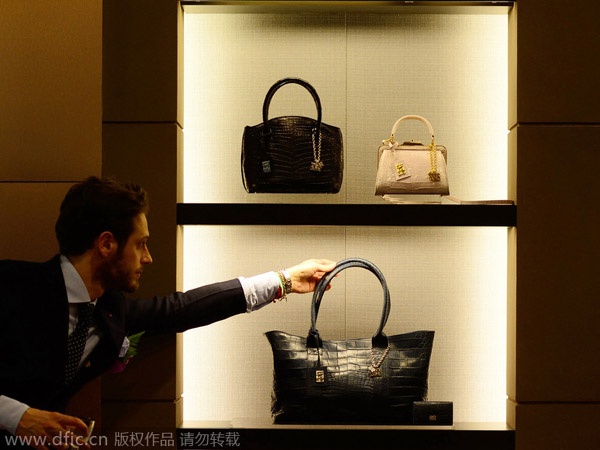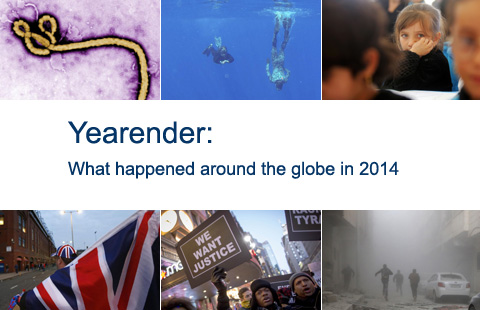China's luxury big spenders: young, trendy and not so rich
Updated: 2015-03-16 08:23
(Agencies)
|
|||||||||||
 |
|
A employee puts a handbag on the display shelf in a store in Hangzhou, Zhejiang in May 18, 2013. [Photo/IC] |
Global luxury brands expanding in China are better off targeting the HENRYs - "high earners, not rich yet" - instead of the ultra-wealthy, as a slowing economy and a government that frowns on official excesses usher in an era of less showy spending.
HENRYs believe less is more. These younger spenders pride themselves on their individualism and snub the ostentatiously branded handbags and accessories loved by the "secretary" types. Fuelling their shopping habits are social media, multi-brand retail websites such as Beijing-based ShangPin.com and Italy's Yoox, eclectic boutiques, and high-end department stores like Lane Crawford and Galeries Lafayette.
Chinese customers aged 25-35 are Yoox's top spenders, International Markets Director Luca Martines told Reuters, adding that they are willing to mix niche labels with big brands. Labels considered niche such as Celine and 3.1 Phillip Lim are among the "hottest" sectors, according to a report last week by online luxury magazine Jing Daily, citing branding and marketing experts.
Affordable labels like Tory Burch, Longines and Michael Kors are also in demand, while pricier, more conventional labels including Cartier, Louis Vuitton and Gucci have been hit by a "cold front", the Jing Daily report added.
"The Chinese consumer is now more educated and less conformist, which means they are less inclined to look like a secretary and go for luxury brands that are overdeveloped," said Lionel Roudaut, head of fashion design and textile at Singapore's LASALLE College of the Arts. "The Internet has also given them access to products not available before."
Related story: Luxury labels embrace 'new normal' as Chinese market shrinks, by Xinhua
SHANGHAI - Nothing could stop Chinese holidaymakers from taking overseas luxury shopping trips this Spring Festival, and no one could stop the souring romance between global luxury brands and the Chinese market.
China's luxury market has experienced a negative trend for the first time after eight years of consecutive growth, according to consulting firm Bain & Co's 2014 China Luxury Market Study, which was released in January.
Growth of luxury goods on the Chinese mainland was down 1 percent to 115 billion yuan ($18.7 billion) in 2014, with watches, men's wear, and luggage and bags being hardest hit, the study showed.
Poor sales vs rich demands
Sales of Swiss luxury giant Richemont dropped 4 percent in the third quarter of 2014, an epitome of the poor performances of some prestigious names including Montblanc, Rolex, Armani and Ferrari.
Hugo Boss shut seven mainland shops in 2014, followed by six shops from Ermenegildo Zegna and four from Burberry.
The amount of polished diamonds imported into China declined for a fourth consecutive month in January as a result of a weak domestic market as well as sluggish global economic recovery, according to the Shanghai Diamond Exchange.
Corruption and bribery were said to have driven unsustainable growth in China's luxury market, where expensive watches, bags and clothes were given in exchange for "favors".
Although luxury retailers are entering winter amid the ongoing anti-corruption campaign, "daigou" (overseas shoppers who buy and send luxury goods to customers in China) are embracing the spring of their career.
Related Stories
Luxury labels embrace "new normal" as Chinese market shrinks 2015-02-25 17:34
Chinese not out of love with luxury 2015-03-09 08:26
Reluctance to spend big at home is the reason 2015-03-09 07:54
Affordable luxury comes to the fore in China 2015-03-09 07:50
Living in the lap of luxury 2015-02-19 15:40
Today's Top News
Putin to meet Kyrgyz president in St. Petersburg
Film on Crimea sparks off quarrels
Germany seeks co-op with China in high-tech area
Air China to start Budapest-Beijing flight, Hungarian minister says
UK seeks to join China-proposed bank
China has 'huge growth potential'
72% worry about retirement life
Fears voiced over violent scenes
Hot Topics
Lunar probe , China growth forecasts, Emission rules get tougher, China seen through 'colored lens', International board,
Editor's Picks

|

|

|

|

|

|





